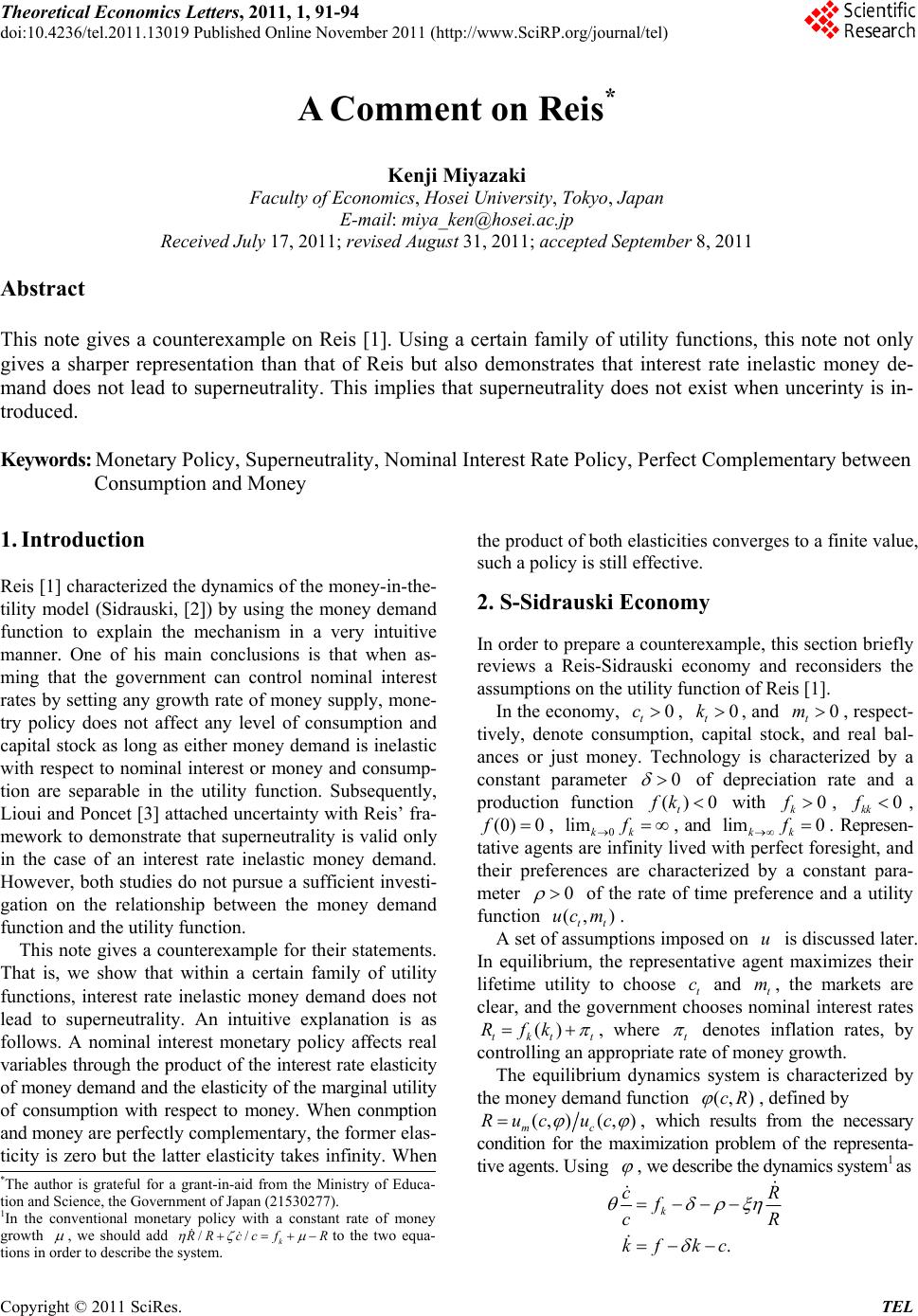
Theoretical Economics Letters, 2011, 1, 91-94
doi:10.4236/tel.2011.13019 Published Online November 2011 (http://www.SciRP.org/journal/tel)
Copyright © 2011 SciRes. TEL
A Comment on Reis*
Kenji Miyazaki
Faculty of Economics, Hosei University, Tokyo, Japan
E-mail: miya_ken@hosei.ac.jp
Received July 17, 201 1; revised August 31, 2011; accepted September 8, 20 1 1
Abstract
This note gives a counterexample on Reis [1]. Using a certain family of utility functions, this note not only
gives a sharper representation than that of Reis but also demonstrates that interest rate inelastic money de-
mand does not lead to superneutrality. This implies that superneutrality does not exist when uncerinty is in-
troduced.
Keywords: Monetary Policy, Superneutrality, Nominal Interest Rate Policy, Perfect Complementary between
Consumption and Money
1. Introduction
Reis [1] characterized the dynamics of the money-in-the-
tility model (Sidrauski, [2]) by using the money demand
function to explain the mechanism in a very intuitive
manner. One of his main conclusions is that when as-
ming that the government can control nominal interest
rates by setting any growth rate of money supply, mone-
try policy does not affect any level of consumption and
capital stock as long as either money demand is inelastic
with respect to nominal interest or money and consump-
tion are separable in the utility function. Subsequently,
Lioui and Poncet [3 ] attached uncertainty with Reis’ fra-
mework to demonstrate that superneutrality is valid only
in the case of an interest rate inelastic money demand.
However, both studies do not pursue a sufficient investi-
gation on the relationship between the money demand
function and the utility fu nction.
This note gives a counterexample for their statements.
That is, we show that within a certain family of utility
functions, interest rate inelastic money demand does not
lead to superneutrality. An intuitive explanation is as
follows. A nominal interest monetary policy affects real
variables through the product of the interest rate elasticity
of money demand and the elasticity of the marginal utility
of consumption with respect to money. When conmption
and money are perfectly complementary, the former elas-
ticity is zero but the latter elasticity takes infinity. When
the product of both elasticitie s converges to a finite valu e,
such a policy is still effective.
2. S-Sidrauski Economy
In order to prepare a counterexample, this section briefly
reviews a Reis-Sidrauski economy and reconsiders the
assumptions on the utility fun c tion of Reis [1].
In the economy, , , and , respect-
tively, denote consumption, capital stock, and real bal-
ances or just money. Technology is characterized by a
constant parameter
0
t
c
0
0
t
k0
t
m
()fk of depreciation rate and a
production function t with , 00
k
f0
kk
f
,
(0) 0f
, 0
limkk
f
, and . Represen-
tative agents are infin ity lived with perfect foresight, and
their preferences are characterized by a constant para-
meter
lim 0
kk
f
0
of the rate of time preference and a utility
function ()
tt
uc m
.
A set of assumptions imposed on is discussed later.
In equilibrium, the representative agent maximizes their
lifetime utility to choose t and t, the markets are
clear, and the government chooses nominal interest rates
t
u
c m
()
tkt
Rfk
, where t
denotes inflation rates, by
controlling an appropriate rate of money growth.
The equilibrium dynamics system is characterized by
the money demand function (cR)
, defined by
()(
mc
Ruc uc)
, which results from the necessary
condition for the maximization problem of the representa-
tive agents. Using
, we descri be the dy namics system 1 as
*The author is grateful for a grant-in-aid from the Ministry of Educa-
tion and Science, the Government of Japan (21530277).
1In the conventional monetary policy with a constant rate of money
growth
, we should add //
k
Rccf R
to the two equa-
tions in order to describe the system.
k
cR
f
cR
kf kc